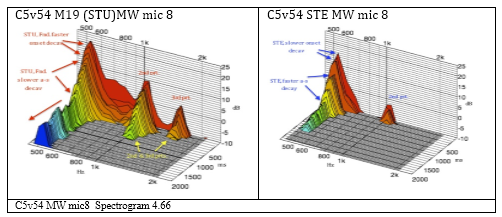C5v54 MW mic 8 Projection, Stuart tonal distinction 5.
| Stuart C5v54 M19(STU) MW mic8.wav |
Steinway C5v54 STE MW mic8.wav |
| Sound table 4.39 | |
The Stuart was 9 dB louder than Steinway at mic 8, at the velocity strike of v54. The attack sound is more present in the Stuart sound. After 1s of, the Steinway sound is heard to rapidly diminish in volume, and settle to a quieter level of sustain than the Stuart. The Stuart sound is not heard to diminish in volume, till approximately 3.5s. The Stuart tonal colour is brighter at the onset, and throughout the after-sound. The larger 2nd and 3rd partials with significantly slower rates of decay are influencing the brighter tone. The Stuart soundboard also resonated larger amplitudes of the 2nd & 3rd partial frequencies.
The Spectrogram below shows, the Stuart fundamental frequency is larger in amplitude, louder, and is decaying at a slower rate than Steinway, after .5s. After .5s, the Stuart sound is audibly heard to sustain more gradually and steadily, than Steinway.


The onset of the Stuart sound (i) decayed at a slightly faster rate than Steinway in the onset of C5v54. The Steinway (ii) transfers earlier than Stuart into its slower after-sound oscillation. The Stuart’s initial period of the after sound oscillation (ii) decays at ta slower rate than Steinway. The Steinway settles into its 2nd phase of after sound (iii) oscillation 1s earlier than Stuart.

Soundboard: The Steinway soundboard vibrated larger magnitudes of the fundamental, 4th , 5th & partial frequencies than Stuart. The Stuart soundboard vibrated a larger 2nd & 3rd partial frequency. The magnitude of the total movement of the Steinway soundboard was found to be 46% higher than the Stuart soundboard for C5v54
String Scale: For the note C5, the diameter of the Paulello-Stuart wire is .35mm thicker, the tensile strength of the Paulello/Stuart wire is 138 N/mm² higher. The Paulello-Stuart wire for C5 is 4.5mm longer, and is set at 7kg higher tension. The yield or capacity of the Paulello-Stuart wire is approximately 10% higher than the Roslau-Steinway wire.




